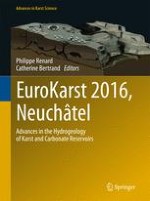2017 | OriginalPaper | Buchkapitel
21. Artificial Neural Networks Modeling of a Karstic Watershed in Mount Lebanon
verfasst von : Antoine Allam, Wajdi Najem
Erschienen in: EuroKarst 2016, Neuchâtel
Aktivieren Sie unsere intelligente Suche, um passende Fachinhalte oder Patente zu finden.
Wählen Sie Textabschnitte aus um mit Künstlicher Intelligenz passenden Patente zu finden. powered by
Markieren Sie Textabschnitte, um KI-gestützt weitere passende Inhalte zu finden. powered by
